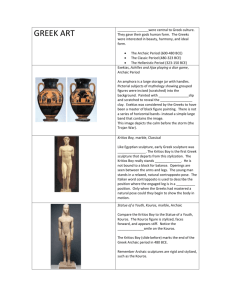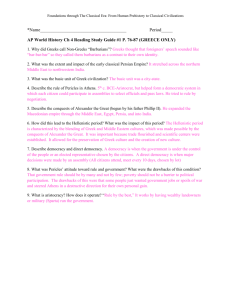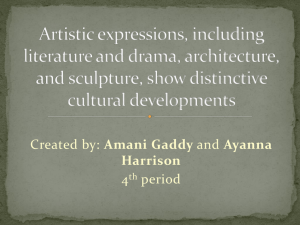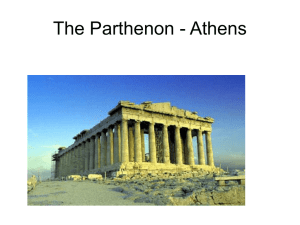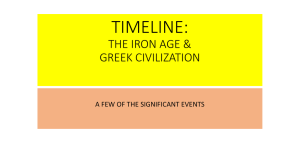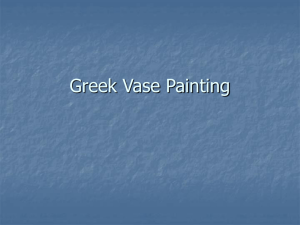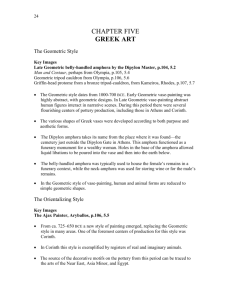AP ART HISTORY
advertisement
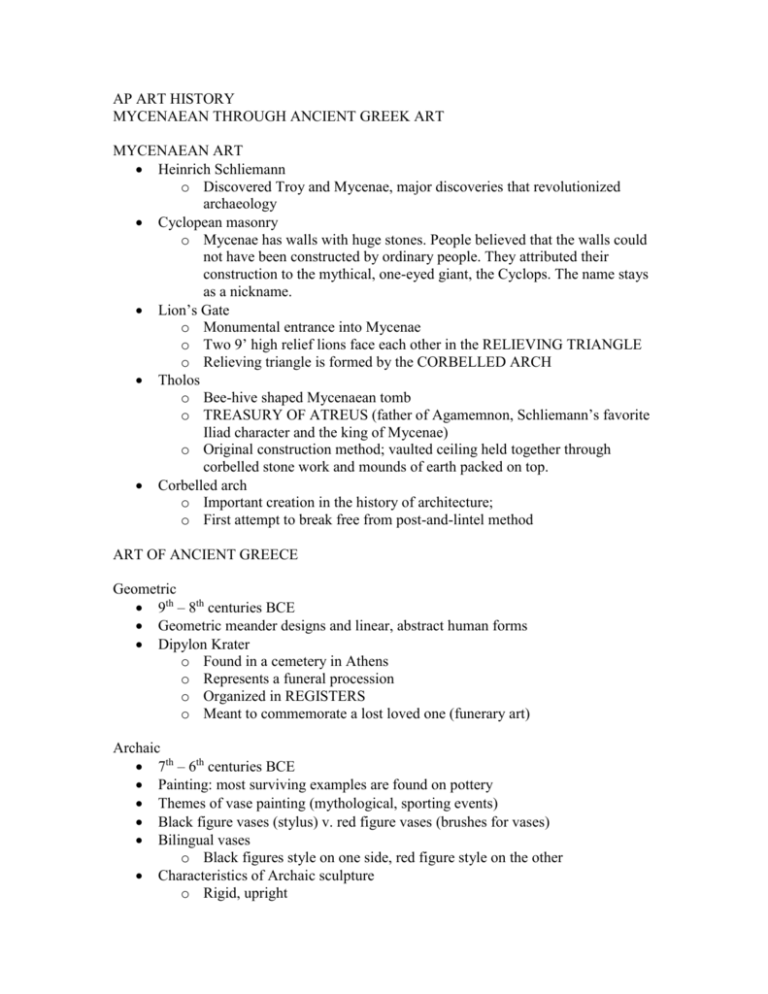
AP ART HISTORY MYCENAEAN THROUGH ANCIENT GREEK ART MYCENAEAN ART Heinrich Schliemann o Discovered Troy and Mycenae, major discoveries that revolutionized archaeology Cyclopean masonry o Mycenae has walls with huge stones. People believed that the walls could not have been constructed by ordinary people. They attributed their construction to the mythical, one-eyed giant, the Cyclops. The name stays as a nickname. Lion’s Gate o Monumental entrance into Mycenae o Two 9’ high relief lions face each other in the RELIEVING TRIANGLE o Relieving triangle is formed by the CORBELLED ARCH Tholos o Bee-hive shaped Mycenaean tomb o TREASURY OF ATREUS (father of Agamemnon, Schliemann’s favorite Iliad character and the king of Mycenae) o Original construction method; vaulted ceiling held together through corbelled stone work and mounds of earth packed on top. Corbelled arch o Important creation in the history of architecture; o First attempt to break free from post-and-lintel method ART OF ANCIENT GREECE Geometric 9th – 8th centuries BCE Geometric meander designs and linear, abstract human forms Dipylon Krater o Found in a cemetery in Athens o Represents a funeral procession o Organized in REGISTERS o Meant to commemorate a lost loved one (funerary art) Archaic 7th – 6th centuries BCE Painting: most surviving examples are found on pottery Themes of vase painting (mythological, sporting events) Black figure vases (stylus) v. red figure vases (brushes for vases) Bilingual vases o Black figures style on one side, red figure style on the other Characteristics of Archaic sculpture o Rigid, upright o Exhibit Egyptian influence o Archaic smile – give a sense of naturalism to the statue o Gradually become more naturalistic but falls short of Classical style Kouros/Kouroi statues, rigid, upright, nude, ideal, youthful male body, slightly abstract, Egyptian influence Kore/Korai statues New York Kouros o First free-standing nude statue in history o Exhibits a strong Egyptian influence (rigid body, tight posture, foot striding forward) o Yet, unique (nudity, open spaces between legs and arms and torso) o Used as a grave marker PEPLOS KORE o Draped maiden wearing a peplos (cloth garment worn by women) o May be a goddess or votive figure o Missing left arm (damaged during Persian invasion of Athens) Pediment sculptures from Temple of Artemis o Archaic statuary o Medusa flanked by two lions – high relief with some low relief – NOT in the round yet o Archaic smile (fierce look – remember she can turn you to stone) Archaic temples o Same key parts (cornice, frieze, and architrave comprise the ENTABLATURE) o Doric Order was just invented; not very refined yet Classical 5th – 4th centuries BCE ANTHROPOMORPHIC GODS/Goddesses (gods with human form); major influence on Greek approach to the human body (Man is the measure of all things; the Greeks took their gods and made them men and took their men and made them gods.) Athens o Ransacked by Persians in Second Persian War o Pericles, elected leader of the city, wanted to rebuild it and make it the most beautiful city in Greece o Wanted to glorify its patron god Athena, the warrior-maiden Rebuilding and glorifying Athens after the defeat of the Persian invasions Statues imitate nature but also idealize it Philosophical ideal that influences Greek art: man is the measure of all things Kritios boy- important early classical/severe style piece, first use of contrapposto (relaxed natural stance) HAIR- Warriors of Riace, Canon aka the Doryphoros o Heroic – gods, goddesses, warriors, and athletes o Aloof – figures are in their own world o Idealized – muscular, fit, beautiful reflecting the form of the gods o Restrained emotion (Classical calm) Warriors of Riace o Classical sculptures discovered by divers off the coast of Italy o Bronze originals o Stand in contrapposto o Represent the ideal Greek warrior (heroic, aloof, idealized bodies, and restrained emotions) Aphrodite of Knidos o First monumental statue of a female in the nude in Greek art o Sculpted by Praxiteles, late Classical sculptor Greek originals v. Roman copies o Romans admired Greek art and took much of it o They hired artists to make many copies. o Much of what we know about Greek art is based on Roman copies (ex. Doryphoros) Apoxyomenos (The Scraper) o Statue of athlete cleaning off after a workout o Sculpted by Lysippos o Demonstrates the humanizing quality of later Classical sculpture (sense of movement and animation – foreshadowing Hellenistic) o LYSIPPOS is also famous for developing a new CANON, modifying Polykleitos’s earlier one Grave stele of Hegeso o Grave stelae replaced koroi/korai statues and pottery as a preferred form of grave marker o Hegeso was young woman who died before she could get married o Holds dowry box on lap looking at treasures (symbolizes she never got married) o Hegeso ignores servant girl and is bigger than she is (HIERARCHICAL SCALE) o Grave stele exudes classical values (calm, interest in anatomy, realism but idealize human figures, sense of depth/perspective with different levels of relief carving) Greek theaters o Semicircular seating o Models of harmonious proportions (balanced, symmetrical, remarkable acoustics) o Used for holding plays on holidays Temples and their purpose: hold a cult statue o Greeks used post-and-lintel construction methods Architecture: parts of temple o Frieze – band of sculpture, part of the entablature of a Greek temple Doric o Masculine Greek order; favorite order among the Archaic and Classical Greeks. o o o o Ionic o o o o Reached its apogee with the Parthenon (Iktinos and Kallikrates) Column height usually 6-7 X the diameter of the column Basic looking capital on column Interrupted frieze made of triglyphs (bands of three vertical grooves) and metopes More feminine Greek order Taller (column height 8-9X diameter of column) and more slender looking VOLUTE – scroll-like capital of an Ionic column Fancy base to the column (Doric column shafts went straight into the stylobate (floor of the temple) o Ionic friezes are CONTINUOUS (no interruptions like Doric friezes with triglyphs) Corinthian o Order that is most grandiose and monumental (column height 10X diameter of column) o Popular with Hellenistic Greeks and later the Romans Acropolis o Elevated hill (300’) in Athens that functioned as a sacred district o Several important temples – Parthenon, Erectheion, Temple of Athena Nike – located there o Most of the temples were built in the 5TH CENTURY after the defeat of the PERSIANS o PROPYLAIA – gatehouse, entranceway to the Acropolis Parthenon and its key elements o Fifth century Doric temple used for holding cult statue of Athena o Architects - Iktinos and Kallikrates o Phidias – sculpted the statue of Athena, in charge of all sculpture for temple o Goal to glorify Athena and make her a special sanctuary o Cella/Naos (sanctuary) held the 40’ statue of Athena designed by Phidias o Ionic continuous frieze on interior level of Panathenaic Procession o Famous for its VISUAL REFINEMENTS (several adjustments made to make the building approach the ideal form of perfection) Parthenon/Elgin marbles and their location o Doric metopes contain narratives of epic battles of civilized Greeks/Greek gods defeating barbaric forces (Amazonomachy, Gigantomachy, Sack of Troy, Centauromachy) o Ionic interior frieze depicted Panathenaic Procession (first time people were elevated to the status of the gods) o Lord Elgin was a British ambassador to the Ottoman Empire, who were Turks who also ruled Greece at the time, in the early 1800s. He obtained permission to take several marbles from the Acropolis to preserve them for posterity. They became part of his garden in Britain and when he died he left them to the British Museum. They have become known as the Elgin Marbles. Ever since the Greeks won their independence from the Ottoman Empire around 1830, they wanted their artwork back. The British Museum refuses to return them claiming that they were obtained through legal means at the time. Today, they remain on display at the British Museum and are a major source of tourist revenue. Three Goddesses o Three reclining goddesses from east pediment of Parthenon o Today in British museum o Exudes Classical values – naturalistic body positions, realistic rendering of drapery, interest in human anatomy – drapery conforms to underlying anatomy Centauromachy (Battle with the Centaurs) o Famous myth about the battle between the first humans (Lapiths) on earth and the centaurs (half man, half horse known to be wild and uncontrollable. o The Lapiths attempted to befriend centaurs and invited them to a wedding reception. The centaurs got drunk and assaulted the guests leading to a war. o Both sides experienced casualties but the Lapiths overcame through their superior intelligence. o Phidias dedicated one side of Doric metopes of the Parthenon to the event. It symbolizes the concept of civilization (aka The Greeks) triumphing over barbarism (aka The Persians). Panathenaic Procession o IONIC FRIEZE on interior level of PARTHENON (Parthenon has two rows of friezes. It is a Doric temple but this is an usual Ionic feature – Ikitinos and Kallikrates wanted to make the Parthenon unique). o Depicts parade in honor of Athena – all different people young and old participate and bring offerings to the Acropolis o First time that humans were elevated to the same level as the gods in art Erectheion and its key features o Complex Ionic temple on Acropolis dedicated to a few different events (ex. contest between Athena and Poseidon) o Caryatids – female shaped columns; part of the Porch of the Maidens of the Erectheion Hellenistic 3rd and 2nd centuries BCE (after death of Alexander the Great) Battle of Issus aka ALEXANDER MOSAIC o Found in Roman home in Pompeii o Made up of over 1 million tesserae (little stones) o Amazing realism and attention to detail o Shows Roman love of Greek art and stories o Mosaic based off an original Hellenistic painting lost to history The E’s of Hellenistic Style o Emotional – do not have the Classical calm o Expressionistic – designed to elicit a feeling from the viewer, not aloof o Everyday people – shopkeepers, old women, defeated boxers Nike of Samothrace (winged victory) o Intended to commemorate a naval victory o Nike would be crowning victorious captain with laurel crown o Theatrical and dramatic display, sense of movement – typical of Hellenistic o One of the “Big Three” of the Louvre (along with Venus de Milo and Mona Lisa) Venus de Milo o Hellenistic era sculpture of Venus (Roman for Aphrodite) o Shows the goddess of love with falling drapery o Famous for its missing arms Pergamon o Major city in Asia Minor; the “Athens of the East” o Center for art and architecture in the Hellenistic world Altar of Zeus at Pergamon o Pergamon became the cultural o Represents the forces of Greek civilization overcoming the forces of barbarism and wildness Laocoon and his sons o Trojan priest killed by sea snakes o Attributed to Hegesandros, Polydoros and Athandoros of Rhodes o Influenced Michelangelo o Exhibits Hellenistic qualities – expressionistic, emotional, theatrical realism Dying Gaul and Gallic chieftain o Created in Pergamon; probably intended for a monument o Demonstrates Hellenistic interest in emotion and realism o Greeks ennobled their enemies to make their triumphs look even better

